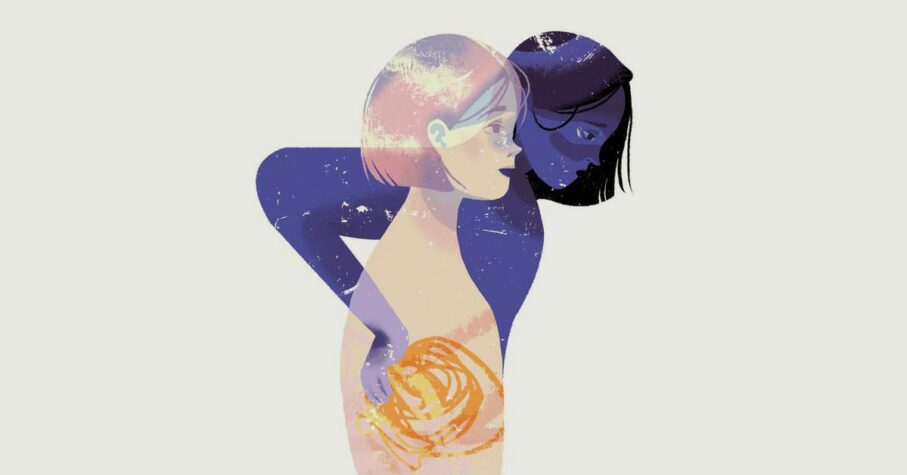
ILLUSTRATION BY RACHEL WADA
By Alison Hodgins | The Globe And Mail
“Excuse me, miss, can you help me with my bag?” The elderly woman smiles at me apologetically while waiting for me to say yes. After all, why wouldn’t I? I look young, fit, healthy and I have my own carry-on suitcase sitting at my feet. It would be rude of me to refuse. For all aesthetic purposes, I look and act like there’s nothing wrong with me. But that’s a lie. At 27, I bumble through life with an invisible injury that provides near-constant pain and fear. I don’t suffer from emotional trauma; I’m not struggling with mental illness. No. I broke my back.
I’m not going to tell you how I shattered my spine, because that’s part of the reason I don’t always bring it up. When people hear about my injury, they are either mortified and want to learn exactly what happened or they say something ridiculous, such as: “Oh, I broke my back, too. I fell down the stairs and was in bed for 10 days! It was horrible, I completely understand what you’re going through.” Unless you’ve gone through two invasive surgeries – the first to align two strips of metal and four screws along your spine and the second to remove the hardware once your bones had healed – unless your back muscles are still relatively non-existent after spending nearly two years relying on metal rods to hold you up, unless you lied in a hospital bed for two weeks after being told, “You’ll likely never walk again,” you don’t completely understand. There’s one other response I sometimes get: dismissal. I’m just being dramatic. It can’t be that serious. I couldn’t really have broken my back or I wouldn’t be standing here, right? Here’s the truth: The doctors never expected me to be standing at all. I’ve met others with my exact fracture that will never walk again.
I feel incredibly lucky and blessed that I can stand at luggage carousels, that I can board a plane with the rest of economy class, that I can hike (slowly), that I can dance (and pay for it the next morning). I often rest my hands on my thighs and thank them for moving. I kiss my knees in utter delight that I can bend them. I wiggle my toes just to feel them graze the floor. But there are some things I can’t do. I can’t sprint, jump or play basketball like I used to; I can’t carry a heavy backpack, I can’t twist fully, I can’t lift suitcases.
I smile back at the elderly lady at the luggage carousel and shrug my shoulders. “I’m sorry,” I say. “I can’t.” I might hate those two words more than I hate the antipathy, pity or suspicion that coat people’s eyes when I tell them I’m broken. Before I fractured my L1 vertebra, I was stubbornly independent. For six months, I travelled Europe solo, carrying everything I needed on my back. My bag was so heavy, bus drivers would refuse to take it. I’d heave the monster into the underbelly of the luggage compartment with the help of my strong core and legs. I didn’t mind. I loved being tough enough, brave enough, independent enough to explore on my own, with everything I needed in two bags I could lift.
I never expected to lose my freedom, my mobility and my innocence so suddenly. Maybe I don’t like explaining what happened to me because it’s inexplicable. A few months after the accident, I brought a photocopy of the medical reports from France to my physiotherapist in northern Alberta. She frowned at the black-and-white writing as if it were an insoluble crossword puzzle. “Well,” she said frankly, “I don’t know how you’re walking.” My twentysomething friends, most of whom had never broken a bone, couldn’t begin to fathom my daily constraints. On a shining summer day, near the river at my hometown, a girl looked at my marked spine and asked me: “Do you have dermal piercings?” “No,” I told her, a lump I disguised as a laugh sticking to my throat. “They’re scars.”
I used to love my back. When I was 19, I tattooed a moon and stars on the left-hand side. But that was before my injury, when I still liked to show off the dimples that sat on either side of my spine. That was only one year before I learned how easily we can break, before I snapped my spine in two. When my back is covered by clothing, I look like any other normal twentysomething. And I’m treated like it. I get glared at on the bus when I take a seat, because standing is still painful. My heart sinks when I walk into a restaurant and realize there are no chairs with backs. People laugh when I lay down on the floor of the airport or train station just to take some pressure off my aching muscles.
Living with an invisible injury is something I’m going to have to deal with for the rest of my life. It’s my battle, but I don’t want to fight alone. Although I’m still independent (travelling is a major part of my job as an online editor for an outdoor adventure magazine), exploring like I did before is no longer a possibility. I’ve learned that I need to be vulnerable and okay with being the one to ask for help. To say no. To say, “I can’t.”
The next time you encounter someone who looks relatively healthy and is struggling, don’t just assume they are being dramatic or rude. You have no idea what trauma they’ve been through, what burdens and scars they carry. Be generous. If you can, offer a helping hand. Don’t demand more of them than they are willing to give. And if you can handle the curiosity, don’t ask them what’s wrong. Just be willing to help.
By Alison Hodgins | The Globe And Mail | Published August 12, 2019
The information contained is as of date of publication and may be subject to change. These articles are intended as general information only.







